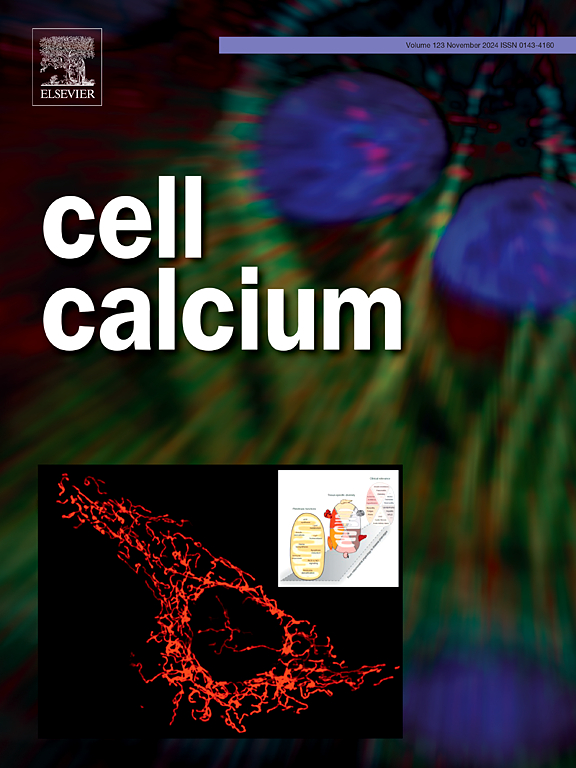CPVT1 point mutations in RyR2 S5 and S6 segments and their Ca2+ signaling consequence
IF 4
2区 生物学
Q2 CELL BIOLOGY
引用次数: 0
Abstract
Precise activation of cardiac ryanodine receptor (RyR2) by small influx of Ca2+ during the action potential triggers the release of SR Ca2+ that activates contraction, a process known as Ca2+-induced Ca2+ release (CICR). Missense mutations in RyR2 often cause aberrant and unregulated Ca2+ releases that are associated with catecholaminergic polymorphic ventricular tachycardia (CPVT), often lethal arrhythmias. Here using CRISPR/Cas9 gene editing in human induced pluripotent stem cells (hiPSCs), we extended our previous studies to include two new arrhythmogenic mutations one, R4822H, located in S5-S6 transmembrane luminal loop near RyR2 selective filter and the other, L4865V, located on S6 segment. TIRF-imaging of voltage-clamped mutant myocytes showed that ICa and caffeine-triggered cytosolic Ca2+ rise (Fura-2 signal) or ER-GCaMP6 SR Ca2+ release signals were significantly suppressed in R4822H but not in L4865V myocytes. Spontaneous Ca2+ transients, however, persisted in both mutant lines activating both Fura-2 and ER-GCaMP6 Ca2+ transients in L4865V cells, but only Fura-2 Ca2+ transients in R4822H mutant. Spontaneous Ca2+ sparks igniting frequencies were similar in both mutants, but spark durations were significantly shorter. Although both of these mutations are located at S5 and S6 transmembrane regions of RyR2, their phenotypes diverge markedly. L4865V mutant does not show suppressed E-C coupling function, while R4822H mutant has completely suppressed CICR suggesting that the spontaneous beating in R4822H mutant results from remodeling of dormant Ca2+ signaling pathway expressed in hiPSC![]() CMs.
CMs.

RyR2 S5和S6片段CPVT1点突变及其Ca2+信号转导作用。
在动作电位期间,通过Ca2+的少量内流精确激活心脏ryanodine受体(RyR2),触发SR Ca2+的释放,激活收缩,这一过程称为Ca2+诱导的Ca2+释放(CICR)。RyR2的错义突变经常引起与儿茶酚胺能多态性室性心动过速(CPVT)相关的异常和不调节的Ca2+释放,通常是致命的心律失常。在这里,我们利用CRISPR/Cas9基因编辑人类诱导多能干细胞(hiPSCs),扩展了我们之前的研究,包括两个新的心律失常突变,一个是位于S5-S6跨膜腔袢靠近RyR2选择过滤器的R4822H,另一个是位于S6段的L4865V。电压箝位突变型肌细胞的tirf成像显示,ICa和咖啡因触发的胞质Ca2+升高(Fura-2信号)或ER-GCaMP6 SR Ca2+释放信号在R4822H中被显著抑制,而在L4865V肌细胞中没有。然而,自发的Ca2+瞬态在两个突变系中持续存在,在L4865V细胞中激活Fura-2和ER-GCaMP6 Ca2+瞬态,但在R4822H突变株中仅激活Fura-2 Ca2+瞬态。自发Ca2+火花点燃频率在两个突变体中相似,但火花持续时间明显短。虽然这两个突变都位于RyR2的S5和S6跨膜区,但它们的表型明显不同。L4865V突变体不表现出抑制E-C偶联功能,而R4822H突变体完全抑制了CICR,这表明R4822H突变体的自发振荡是由hipsccm中表达的休眠Ca2+信号通路的重塑引起的。
本文章由计算机程序翻译,如有差异,请以英文原文为准。
求助全文
约1分钟内获得全文
求助全文
来源期刊

Cell calcium
生物-细胞生物学
CiteScore
8.70
自引率
5.00%
发文量
115
审稿时长
35 days
期刊介绍:
Cell Calcium covers the field of calcium metabolism and signalling in living systems, from aspects including inorganic chemistry, physiology, molecular biology and pathology. Topic themes include:
Roles of calcium in regulating cellular events such as apoptosis, necrosis and organelle remodelling
Influence of calcium regulation in affecting health and disease outcomes
 求助内容:
求助内容: 应助结果提醒方式:
应助结果提醒方式:


